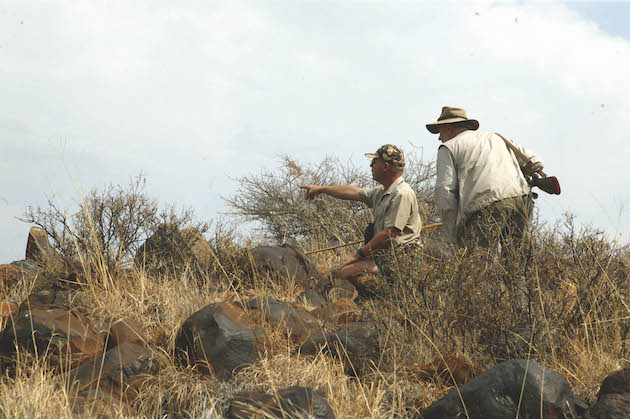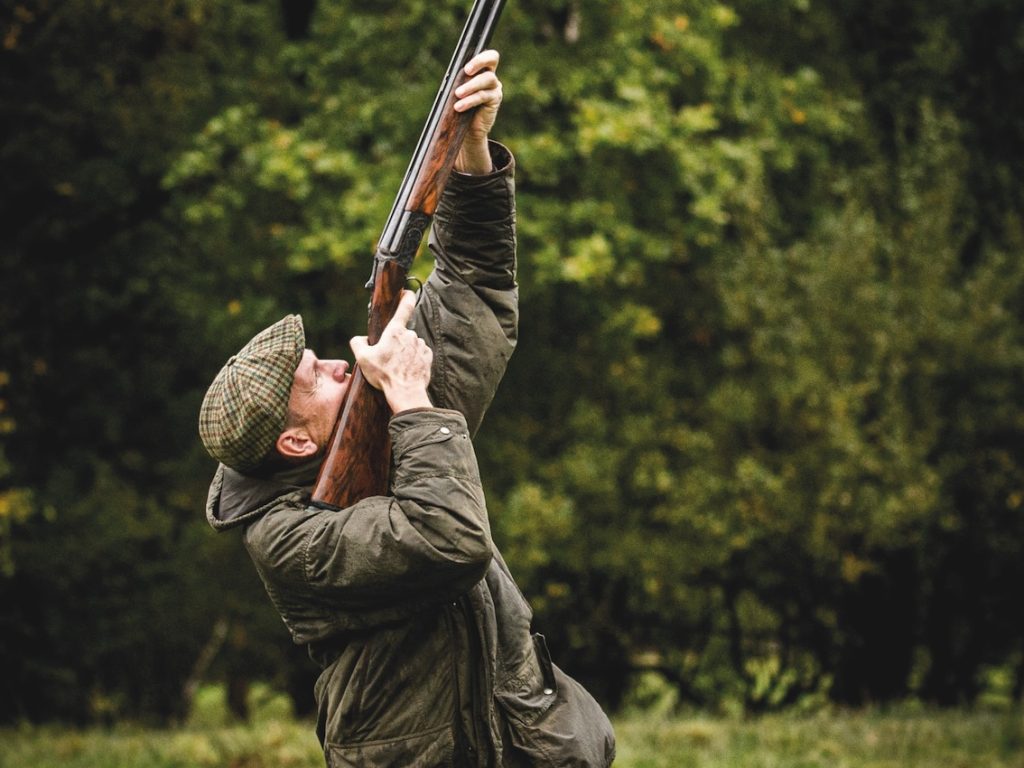Win CENS ProFlex DX5 earplugs worth £1,149 – enter here
Trophy hunting: when it’s well-managed, it’s a force for good
 P.Quagliana. SEPT 2005. Hans and Charles nearing some gemsbok, viewed from the top of a koopie_CHECK SPELLING
Usd 10 aug 16 nws 6
P.Quagliana. SEPT 2005. Hans and Charles nearing some gemsbok, viewed from the top of a koopie_CHECK SPELLING
Usd 10 aug 16 nws 6
When I first moved to the UK from South Africa, I knew how much of a contributor to wildlife conservation regulated big game trophy hunting is. And of all the wildlife conservationists I’d met and idolised growing up in southern Africa, most of them were pro-hunting, or recognised that hunting could be a force for good.
Even the late, great, Dr Ian Player, who masterminded Operation Rhino, a programme in the 1980s that brought the southern white rhino back from the brink of extinction, recognised the value in commercial hunting. “Hunting led to the increase from 437 rhino in 1953 to in excess of 18,000 in 2010,” he said in an interview in 2009. “For the loss of a few animals (for the purposes of trophy hunting), their overall numbers increased. Regrettably, this is a form of logic that is lost on most people.”
It didn’t take me long to realise that my positive views on big game hunting weren’t shared by many of my fellow students. But what has really surprised me over the years is how many game shooters have an issue with trophy hunting. I find this counter-intuitive and, frankly, quite hypocritical, particularly from those who happily shoot reared pheasants and partridges that are driven over their heads.
Trophy hunting facts
I have always argued that effective wildlife management and conservation, whether it’s in the UK, Africa or anywhere else, requires pragmatism. Emotion isn’t helpful when you’re making decisions about what is best for an ecosystem or threatened species — facts are.
When you look at the cold, hard facts, it is clear that trophy hunting plays a crucial role in the conservation and management of Africa’s wildlife in many remote areas. I’ve seen it with my own eyes, time and time again, in several African countries.
And the reason why this isn’t widely known? Because tabloid headlines about cruel American dentists slaying anthropomorphised lions sell newspapers. The lazy, polarising narrative of ‘barbaric big white hunter vs poor, defenceless animal’ makes for sickeningly sensationalist stories, ones that are far easier to roll into 400 words of journalistic phlegm than the complex socio-economic challenges of protecting wildlife in poverty-stricken countries. Elephants and lions seem to be valued more highly than people by many Westerners who, having read a few half-truths on the BBC news app or Daily Mail website, feel qualified to offer their advice on how Africans should manage their natural resources, and are quick to condemn hunters caught up in the ensuing media storm to damnation.
Of course, that emotionally charged rhetoric is trotted out by celebrities such as Ricky Gervais and Piers Morgan because it’s popular. Who wouldn’t side with Cecil when the only information you have is that some rich American paid to shoot him with a crossbow (which isn’t true)?
Brutal reality
As an aside, whenever I hear or read stories about how these animals probably suffer slow, painful, tragic deaths — which, of course, as any stalker knows, is nonsense — I can’t help but wonder how people think these animals’ lives would end if they weren’t despatched by a rifle brandished by a hunting client, whose much-needed trophy hunting fees will be fed back into the rural African economy and into this proven wildlife conservation model. I doubt many of them have witnessed the brutal reality of what happens to a lion when it no longer has the strength to fend for itself. I have, and it is horrific. I know which death I would choose.
But this unpopular, unpalatable truth is more complicated and more nuanced, and requires a slightly deeper understanding of the complexities of wildlife and habitat management in Africa. In very simple terms, hunting can contribute towards maintaining wildlife populations and biodiversity by giving wild animals a value far greater than that of their meat, particularly in areas that do not boast the densities of large ungulates or spectacular scenery required to attract tourists in sufficient numbers to make photographic safaris viable.
Not all of sub-Saharan Africa looks like the Serengeti or Masai Mara. In fact, most of it doesn’t. But these lower-density wildlife areas are, collectively, just as important — if not more so — in ecological terms, as the pan handle in the Okavango Delta or the Ngorongoro Crater. And it is in these areas — both private and state-owned — where trophy hunting can be the financial driver (or a major part of it) that gives local people the incentive to conserve wildlife rather than eat it or eradicate it to make way for livestock or crops that are poorly suited to semi-arid climates and thin, sandy soils.
In South Africa, hunting has done just that: on a typical, conventional grassland ranch, the return on investment from game ranching is several times higher than it is for cattle ranching. Wildlife industries now contribute more than 10 billion rand (over half a billion pounds) to South Africa’s GDP, and privately owned game reserves and ranches amount to in excess of 20 million hectares, supporting more than 16 million head of game — 10 times as many as there are in Kruger National Park — making private land crucial to South Africa’s wildlife conservation efforts.
Supporting wildlife
Just as grouse moors and well-run sporting estates support myriad wildlife, so do these ranches and reserves. Thousands of other species benefit as monocultures or maize, sunflowers, sugarcane and citrus are turned back into native savanna, scrubland, woodland and grassland. Hunting is one of the key economic drivers for these wildlife industries. It provides people with the incentive to protect their wildlife, particularly species such as rhino and elephant, which are highly valued by the illegal wildlife trade.
Conversely, when this wildlife is no longer seen as a financial asset, the incentive to nurture it, manage it and sustain it is lost, and the consequences can be severe. After a trophy hunting ban was implemented in Botswana, which is home to an estimated 130,000 elephants, in 2014 (which is now being lifted), safari operators who had managed hunting concessions in remote corners of Botswana for years, were forced to up sticks and leave behind the infrastructure, staff and land they had financed for many years.
“Twenty elephants were hunted in Sankuyo (a 400,000-hectare hunting concession in northern Botswana) each year,” explains veteran professional hunter, wildlife artist and conservationist James Quin. “This fed 300 people, and additional meat was dried and sold in town. We (the hunting operators) also financed a medical clinic and school for the local community, and we employed 20 local people in camp.
“When hunting was banned, the camp, the clinic and the school all went. We switched off our pumps and the waterholes dried up, resulting in a huge loss of wildlife. In addition, the local people still needed meat, so they resorted to poaching. They didn’t have the wherewithal to hunt elephant, so they snared the plains game. There were herds of 500 buffalo in that area; now you don’t even see an impala. It has been all been poached out.”
Poverty and poaching
“The human rural population is doubling every 20 years,” says veteran wildlife author Ron Thomson. “Twenty-five per cent of South Africa’s population is unemployed, and it is poverty that is driving the current poaching juggernaut. Today, the poaching problem is focused on the rhino — tomorrow, who knows what it will be. But today’s rhino poaching is just the beginning of a coming avalanche. With the kind of poverty-stricken human pressure that is still to come (even within our gazetted national parks), what chance has wildlife to survive the century?”
This is the gritty, unpopular reality of 21st-century wildlife conservation in Africa. And at the heart of it is the same question: can we put our sentimentality aside for the greater good of our natural resources? Because, in my opinion, as unpalatable as trophy hunting may be to some, that is what it is going to take. I really do believe that if we allow our emotions to get in the way of finding and implementing the most practicable solutions to human-wildlife conflicts, much of Africa’s wildlife will, like the northern white rhino, be doomed.
Related Articles
Get the latest news delivered direct to your door
Subscribe to Shooting Times & Country
Discover the ultimate companion for field sports enthusiasts with Shooting Times & Country Magazine, the UK’s leading weekly publication that has been at the forefront of shooting culture since 1882. Subscribers gain access to expert tips, comprehensive gear reviews, seasonal advice and a vibrant community of like-minded shooters.
Save on shop price when you subscribe with weekly issues featuring in-depth articles on gundog training, exclusive member offers and access to the digital back issue library. A Shooting Times & Country subscription is more than a magazine, don’t just read about the countryside; immerse yourself in its most authoritative and engaging publication.







